Exploring the Architectural Marvels of Foguang Temple
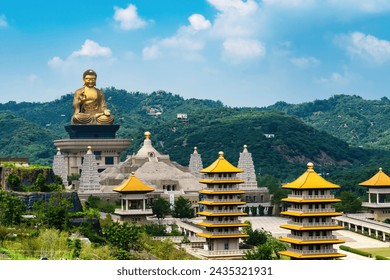
An Essential Guide to Visiting Foguang Temple
In This Guide
- An Essential Guide to Visiting Foguang Temple
- The Rich History and Legends of Foguang Temple
- Main Highlights: What You Absolutely Can’t Miss
- Planning Your Visit: A Practical Guide
- Tickets: Prices, Booking, and Tips
- How to Get There: A Complete Transportation Guide
- Local Cuisine and Accommodation Nearby
- Frequently Asked Questions
- Final Thoughts on Your Trip
Discovering the Serenity of Fo Guang Shan
Nestled in the lush landscapes of southern Taiwan, Fo Guang Shan (佛光寺) stands as a beacon of peace and enlightenment, drawing over ten million visitors each year. As the largest monastery in Taiwan and a pivotal center for Humanistic Buddhism, this sprawling complex encapsulates the essence of a modern spiritual journey. With its intricate architecture, serene gardens, and a multitude of cultural exhibits, Fo Guang Shan invites travelers to delve deep into the teachings of Buddhism while experiencing the harmonious blend of ancient traditions and contemporary life.
From the moment you step onto the meticulously designed grounds, you will be enveloped in an atmosphere that encourages reflection and discovery. A stunning array of statues, pagodas, and halls awaits you, each telling a unique story about the rich heritage of Buddhism and its relevance in today’s world. Whether you seek spiritual solace, cultural enrichment, or simply a picturesque escape, Fo Guang Shan offers an experience that transcends the ordinary.
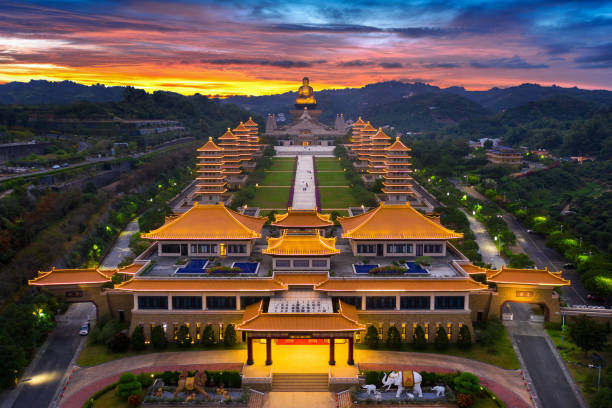
Foguang Temple.
What to Expect During Your Visit:
– A World of Learning: Engage with interactive displays and educational facilities that make Buddhist teachings accessible to everyone, regardless of prior knowledge.
– Breathtaking Architecture: Marvel at the Great Hero Hall, home to the revered Buddha tooth relic, and the monumental pagodas that line the main walkway, each representing core Buddhist principles.
– A Haven of Tranquility: Stroll through peaceful gardens, witness daily rituals, and perhaps even join in a morning chanting session that emphasizes gratitude towards all living beings.
Plan your visit wisely—allow ample time to explore this extraordinary sanctuary, as the sights and experiences will leave a lasting impression that resonates long after you leave. Join us as we navigate the essential aspects of visiting Fo Guang Shan, ensuring your journey is as enlightening as it is enjoyable.
The Rich History and Legends of Foguang Temple
Fo Guang Shan Monastery, a monumental testament to the evolution of Buddhism in Taiwan, has a rich tapestry of history and legends that weave through its expansive grounds. The monastery, founded in 1949 by the visionary monk Hsing Yun, has not only become a spiritual haven but also a symbol of modern Buddhism’s adaptation to contemporary life.
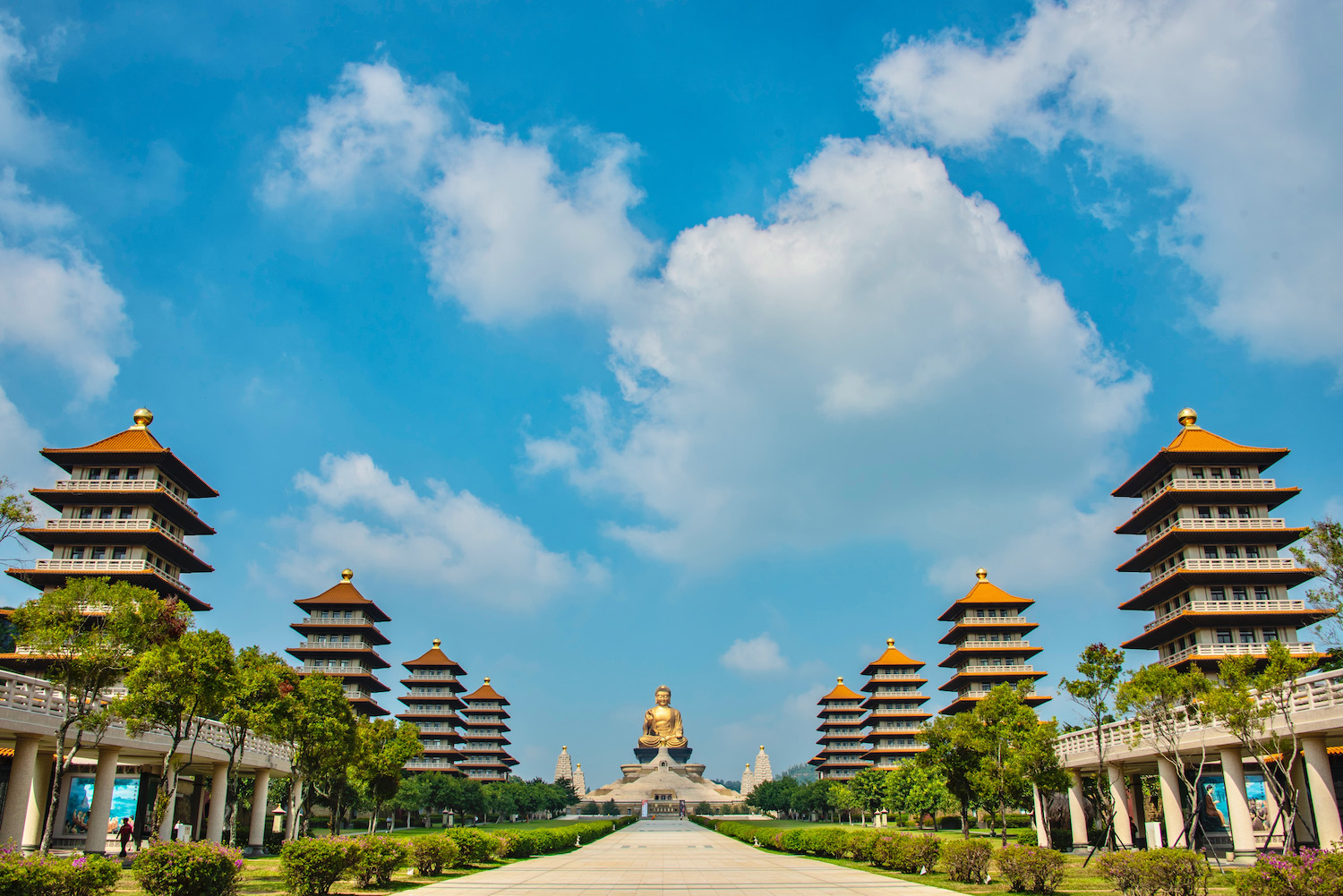
Foguang Temple.
The Beginnings of Fo Guang Shan
Hsing Yun arrived in Taiwan as a young monk fleeing Communist China, armed only with his robes and an indomitable spirit. The local population, steeped in folk Buddhism and ancestral worship, viewed mainland monks with skepticism and suspicion. Hsing Yun faced significant challenges in gaining acceptance, but his persistent outreach across Taiwan laid the foundation for what would become one of the largest Buddhist organizations in the world.
Over nearly two decades, he traveled the length and breadth of Taiwan, establishing schools, youth groups, and offering free lectures. His philosophy was clear: Buddhism should not be an escape from life’s realities but a guide to navigating them. This revolutionary approach resonated with many, leading to the establishment of Fo Guang Shan as a center for what is now known as Humanistic Buddhism.
A Place of Learning and Enlightenment
Fo Guang Shan’s growth was rapid. By 1966, it had secured a 30-hectare site in the lush bamboo forests of Kaohsiung, transforming it into a spiritual and educational hub. The monastery emphasizes a blend of traditional teachings with modern educational practices, housing universities and cultural institutes alongside its religious functions. Today, it attracts over 10 million visitors each year, making it a vital part of Taiwan’s cultural landscape.
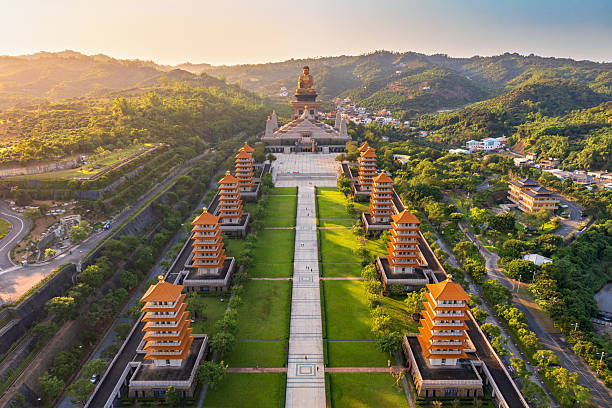
Foguang Temple.
Architectural Marvels and Symbolic Structures
The monastery is renowned for its striking architecture and symbolic structures, each with their own legends and significance. The Main Walkway, known as the “Way to Buddhahood,” extends 240 meters and is flanked by eight towering 38-meter pagodas. Each pagoda encapsulates key Buddhist teachings, reflecting the core principles that guide practitioners on their spiritual journeys.
The Great Hero Hall
At the heart of Fo Guang Shan lies the Great Hero Hall, a colossal structure that houses three majestic 7.8-meter Buddha statues representing Sakyamuni, Amitabha, and the Medicine Buddha. This hall is not just a place of worship; it is also home to the revered Buddha tooth relic, a sacred object that symbolizes a direct connection to the historical Buddha. The relic’s journey to Taiwan involved complex diplomatic negotiations, infusing it with a rich narrative of international Buddhist relations.
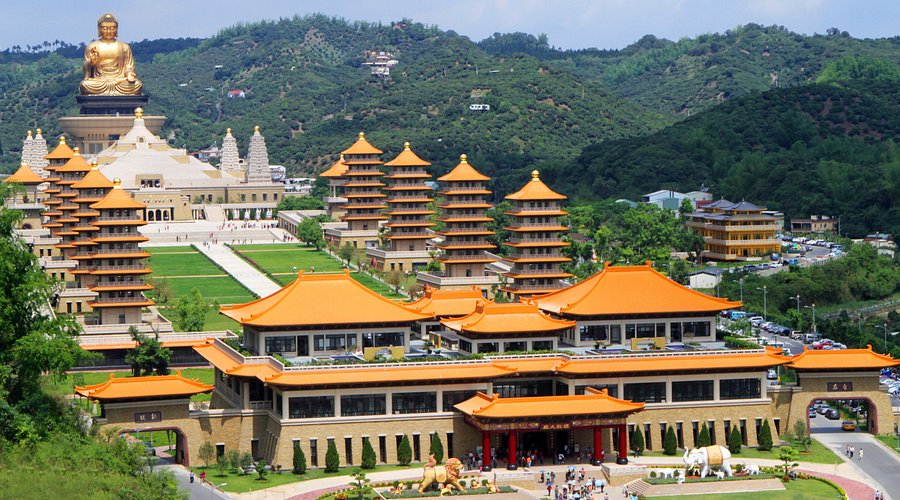
Foguang Temple.
Legends and Spiritual Significance
Legends abound in the rich soil of Fo Guang Shan’s history. One tale speaks of Hsing Yun’s vision to create a Buddhist haven where the teachings of the Buddha could thrive in modern society. It is said that during his early struggles, he once caught a glimpse of a radiant light in the forest that inspired him to continue his mission despite the odds.
The annual Peaceful Lantern Festival, which draws thousands of participants, celebrates the light of wisdom and compassion, embodying the monastery’s broader mission of spreading peace and understanding through Buddhist teachings.
Conclusion: A Living Legacy
Fo Guang Shan is not merely a historical site; it is a living, breathing testament to the adaptability and resilience of Buddhism in the modern world. Through its educational initiatives, humanitarian efforts, and spiritual practices, it continues to influence millions. Each visitor who walks its sacred grounds becomes part of a story that spans decades, a narrative of enlightenment that connects the past to the present and inspires future generations.
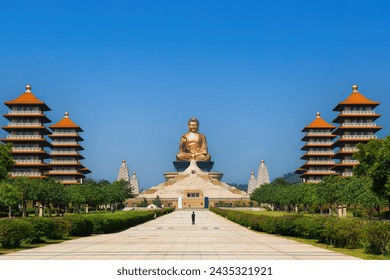
Foguang Temple.
In exploring Fo Guang Shan, one not only discovers the profound depths of Buddhist philosophy but also becomes part of a vibrant community dedicated to the pursuit of harmony and understanding in our complex world.
Main Highlights: What You Absolutely Can’t Miss
When visiting Fo Guang Shan Buddha Museum, a journey through Taiwan’s largest monastery, you’ll find a breathtaking blend of spirituality, culture, and modernity. Below are the essential highlights that you absolutely cannot miss during your exploration of this remarkable site.
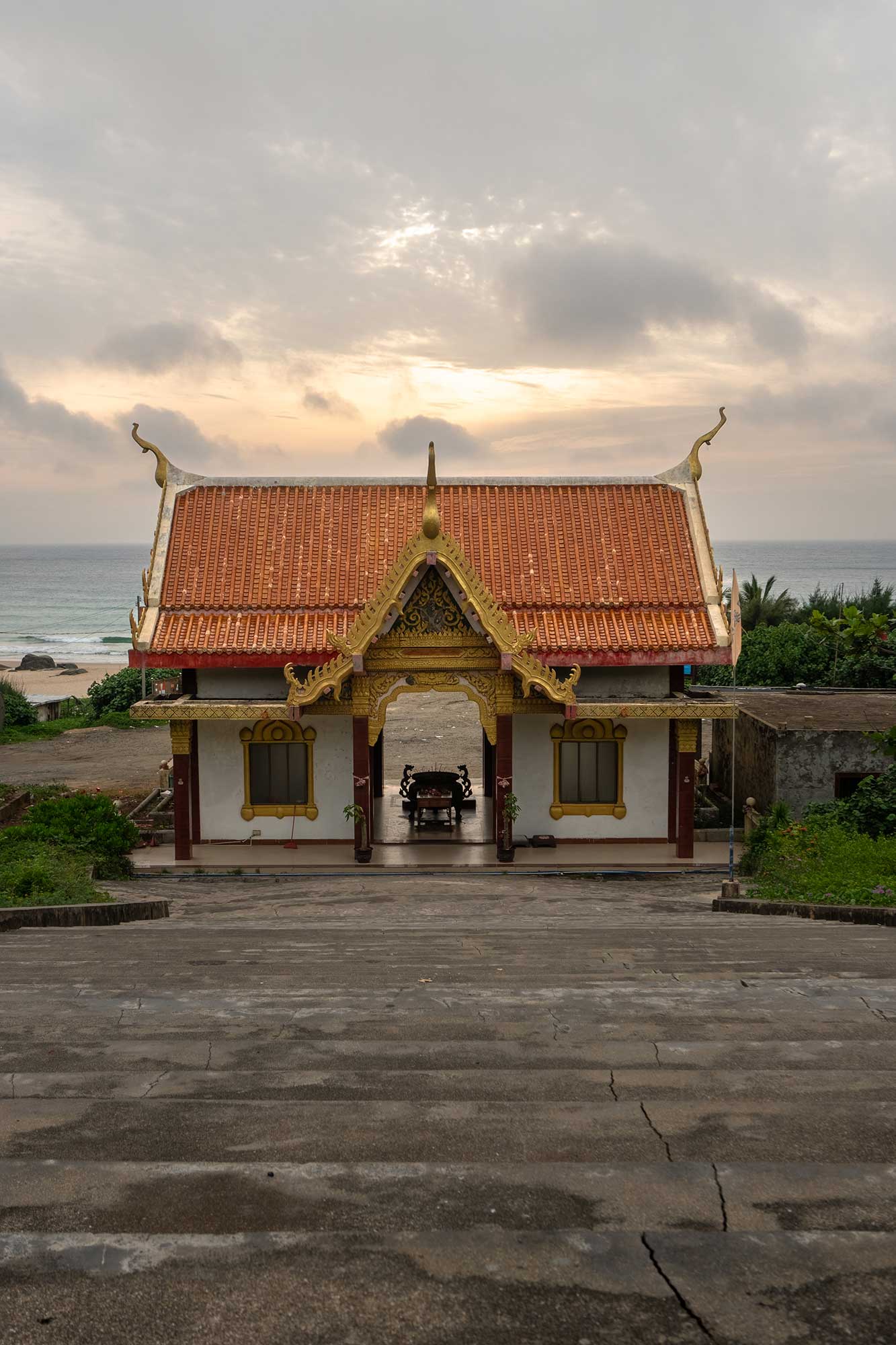
Foguang Temple.
The Grand Entrance: Front Hall
As you arrive, the Front Hall welcomes you with its modern architecture, featuring cafes, restaurants, and souvenir shops. Among them, a vegetarian Starbucks stands out, offering a quirky juxtaposition of commerce and spirituality. While you might feel a bit skeptical at first, grab a bubble tea from Hi Lai Café and prepare to dive deeper into the heart of Buddhist teachings.
The Path to Enlightenment: Main Walkway & Eight Pagodas
Stroll down the Main Walkway, known as the “Way to Buddhahood,” which stretches an impressive 240 meters, flanked by Eight Pagodas standing 38 meters tall. Each pagoda embodies fundamental Buddhist teachings, such as the Eightfold Path and the Six Perfections. Although climbing the pagodas is not permitted, their grandeur is awe-inspiring. The peaceful ambiance, especially during quieter weekdays, enhances the experience as you reflect on the teachings represented by these monumental structures.
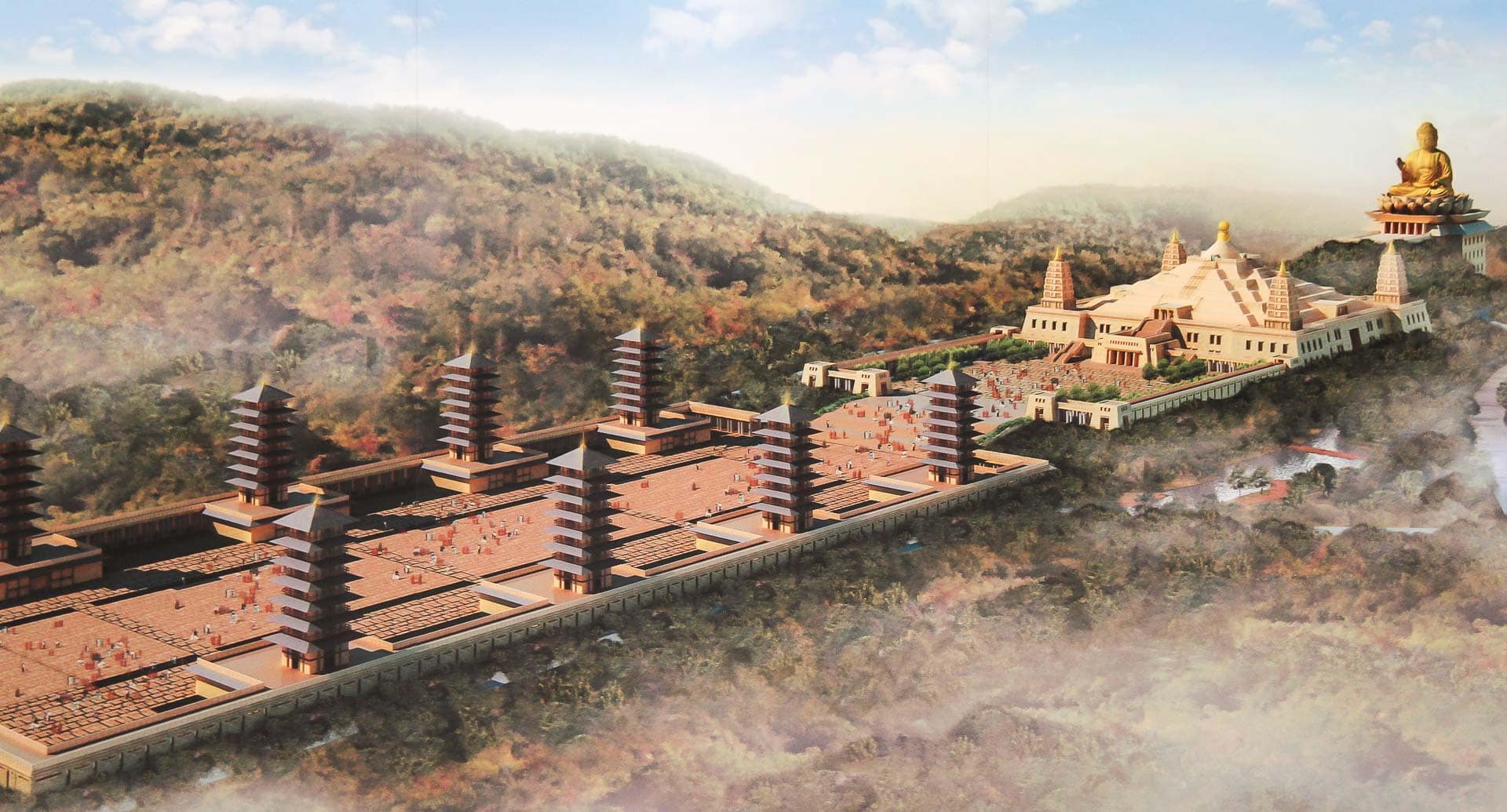
Foguang Temple.
Awe-Inspiring Architecture: Great Hero Hall
The Great Hero Hall is a must-see. This expansive three-story structure houses three towering Buddha statues—Sakyamuni, Amitabha, and Medicine Buddha—each flanked by 14,800 smaller Buddha statues that fill the hall’s walls. This incredible collection of statues is a testament to the devotion of countless donors. Do not miss the Jade Buddha Shrine, which contains a sacred tooth relic of the historical Buddha, a connection to the very roots of Buddhism. Remember to remove your shoes before entering—a sign of respect in Buddhist tradition.
Immersive Learning: Buddha Museum
The Buddha Museum itself is a treasure trove of knowledge. Spend time exploring the interactive exhibits that showcase Buddhist history and practices across various cultures. Each display is designed to be accessible and engaging for visitors of all backgrounds, making it an enriching experience for both Buddhists and non-Buddhists alike.
Tranquility and Reflection: Vulture Peak & Pure Cave Land
For those seeking a quieter space for contemplation, head to Vulture Peak and Pure Cave Land. These areas offer serene environments where visitors can meditate and reflect on the teachings of Buddhism amidst nature’s beauty. The tranquility found here is a perfect counterbalance to the more bustling areas of the monastery.
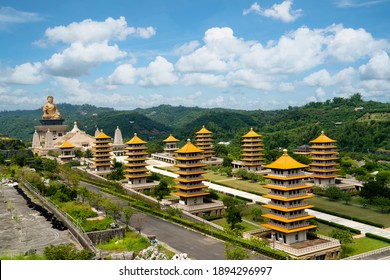
Foguang Temple.
Special Events and Ceremonies
If your visit coincides with one of the many ceremonies held throughout the week, such as the 5:30 AM chanting session, be sure to participate. These events emphasize gratitude and foster a deeper connection to the community and the teachings of Buddhism.
Accessibility and Amenities
Fo Guang Shan is designed to be accessible for all visitors. With wheelchair-friendly pathways and ample facilities, everyone can enjoy the spiritual and cultural wealth this site has to offer.
Practical Information for Visitors
- Entrance Fee: Free (donations are welcome)
- Opening Hours:
- Monastery: 8:00 AM – 5:00 PM daily
- Buddha Museum: 9:00 AM – 6:00 PM on weekdays, 9:00 AM – 7:00 PM on weekends
- Getting There: A direct shuttle bus from Kaohsiung takes approximately 1.5 hours.
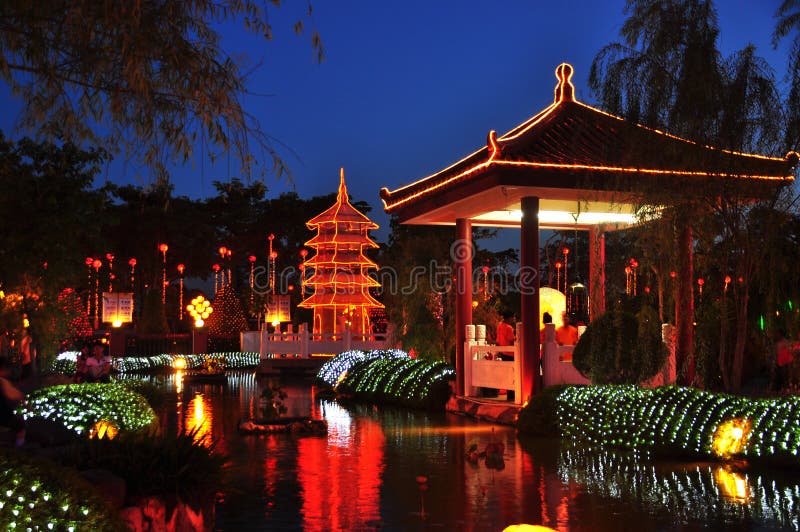
Foguang Temple.
Final Thoughts
Fo Guang Shan Buddha Museum is not just a tourist attraction; it’s a vibrant spiritual community that invites reflection and understanding. Whether you are a devout Buddhist or simply curious about Eastern philosophies, this remarkable complex offers insights into a way of life that integrates spirituality with everyday living. Prepare to be awed, inspired, and perhaps even transformed by your visit.
Planning Your Visit: A Practical Guide
Essential Guide for Visiting Fo Guang Shan Buddha Museum
Fo Guang Shan Buddha Museum, a majestic testament to Humanistic Buddhism, is not just a spiritual haven but a cultural landmark in Taiwan. As one of the most visited places in the country, it offers a rich blend of history, art, and spirituality. To ensure you make the most of your visit, here’s a practical guide packed with essential information.
Getting There
Location:
Fo Guang Shan is situated approximately 20 kilometers from Kaohsiung, making it easily accessible for a day trip.
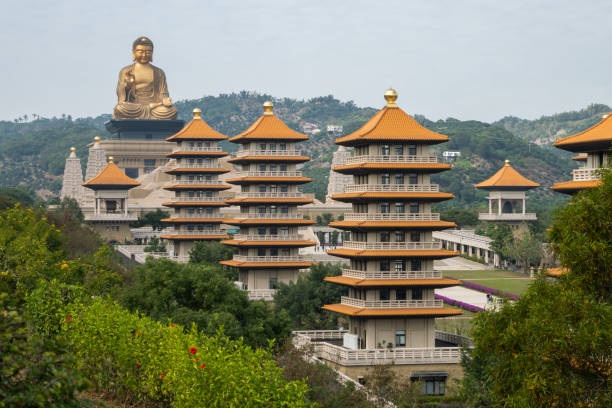
Foguang Temple.
Transportation Options:
– Bus: The most straightforward route is to take the 8010 or 8011 shuttle bus from Jianguo Station, a mere five-minute walk from Kaohsiung Station. The journey takes around 1 hour and 30 minutes.
– Express Route: For a quicker option, take the red line to Zuoying Station and transfer to the E02 Hafo Express, which takes about 50 minutes.
– Payment: Both bus options accept the EasyCard, a convenient method for public transport.
Tip: If you’re planning to return after your visit, arrive at the bus stop early to secure a seat, as queues can be long.
Admission and Opening Hours
- Entrance Fee: Free! Although donations are encouraged, there is no compulsory entry fee.
- Hours of Operation:
- Monastery: 8:00 AM – 5:00 PM daily
- Buddha Museum:
- Weekdays: 9:00 AM – 6:00 PM (7:00 PM for the Main Hall)
- Weekends: 9:00 AM – 7:00 PM (8:00 PM for the Main Hall)
- Closed on Tuesdays (except for special dates).
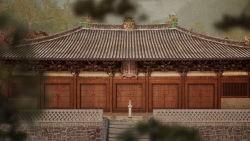
Foguang Temple.
Dress Code and Accessibility
- Dress Code: Modest attire is required. Sleeveless tops, shorts, and short skirts are not permitted. Comfortable slip-on shoes are recommended, as you will need to remove them to enter the temples.
- Accessibility: The complex is fully wheelchair accessible, ensuring that everyone can enjoy the serene environment.
What to Expect
Fo Guang Shan is a vast complex, so allocate ample time to explore its many facets. A visit can easily take several hours. Here’s a snapshot of what you can see:
- Front Hall: The first area you’ll encounter, featuring cafes (including a vegetarian Starbucks), souvenir shops, and information desks.
- Main Walkway + Eight Pagodas: A stunning path flanked by tall pagodas, each representing key Buddhist teachings. This area is perfect for both reflection and photography.
- Main Hall (Great Hero Hall): Home to the impressive Great Buddha and the sacred Buddha tooth relic. Remember to remove your shoes before entering.
- Art Museum: Delve into Buddhist art and history through interactive displays.

Foguang Temple.
Recommended Experiences
- Chanting Sessions: Participate in the daily chanting sessions at 5:30 AM, a beautiful way to connect with the spiritual ambiance of the site.
- Explore the Grounds: The complex encompasses gardens, meditation areas, and numerous statues, including the mesmerizing 1,000 golden Buddhas.
Refreshments and Dining
While there are several dining options available, including vegetarian restaurants, consider trying:
– Hi Lai Café: Ideal for refreshing bubble tea as you meander through the grounds.
Accommodation
If you wish to extend your visit, consider staying in Kaohsiung. The Cloud Hotel is a convenient choice, offering comfortable rooms and a delicious breakfast buffet near key attractions.
Final Thoughts
Visiting Fo Guang Shan Buddha Museum is a journey that enriches both the mind and spirit. With its unique blend of culture, art, and spirituality, it promises a memorable experience for all who tread its paths. Plan ahead, stay hydrated, and immerse yourself in the beauty of this remarkable place!
Tickets: Prices, Booking, and Tips
Visiting Foguang Temple: Ticket Information and Practical Tips
When planning your visit to Foguang Temple (佛光寺), also known as Fo Guang Shan Buddha Museum, it’s essential to have the latest information on entrance fees, booking options, and useful tips to enhance your experience. This sprawling complex in Kaohsiung is a cultural and spiritual haven, drawing millions of visitors every year, so being well-prepared can make all the difference.
Entrance Fee
One of the most appealing aspects of visiting Foguang Temple is that entrance is completely free! While donations are welcomed and appreciated, they are not a requirement for entry. This accessibility allows visitors from all backgrounds to explore the rich history and beautiful architecture without the burden of ticket costs. Should you wish to contribute, donations can be made in person or through their official website.
Opening Hours
Foguang Temple operates on the following schedule:
- Monastery Hours: 8:00 AM – 5:00 PM daily
- Buddha Museum Hours:
- Weekdays: 9:00 AM – 6:00 PM (until 7:00 PM in the Main Hall)
- Weekends: 9:00 AM – 7:00 PM (until 8:00 PM in the Main Hall)
Note: The museum is closed on Tuesdays, except for special dates which can be confirmed on their website. Additionally, daily chanting sessions begin at 5:30 AM, welcoming visitors to partake in this serene experience.
Booking Options
While you do not need to book tickets in advance, consider the following options to streamline your visit:
- Guided Tours: If you want a more in-depth experience, guided tours are available which often include visits to other attractions in Kaohsiung as well. These can be booked online or at local travel agencies.
- Public Transportation: Utilizing an EasyCard is highly recommended for easy access to Fo Guang Shan via bus or train, ensuring a hassle-free journey.
Getting There
Located approximately 20 kilometers from Kaohsiung, Fo Guang Shan is accessible via two main transport routes:
- Shuttle Bus: Take the 8010 or 8011 shuttle bus from Jianguo Station, a short walk from Kaohsiung Station. This journey typically takes about 90 minutes.
- Express Bus: For a quicker option, take the MRT Red Line to Zuoying Station, then transfer to the E02 Hafo Express, which takes around 50 minutes.
Tips for Your Visit
-
Dress Modestly: Visitors are required to dress respectfully, so avoid sleeveless tops, shorts, or short skirts. Comfortable slip-on shoes are advisable since you will need to remove them when entering the temples.
-
Stay Hydrated: The temple grounds are vast, and there is minimal shade. Bring water and consider an umbrella for sunny days.
-
Plan Your Time: With so much to see, allocate at least half a day for exploration. Many visitors find they wish they had more time to soak in the tranquility and beauty of the site.
-
Photography Rules: While photography is allowed outdoors, be respectful of the rules inside shrines and meditation halls where it is typically restricted.
-
Dining Options: Don’t miss out on the on-site dining experiences, including a vegetarian Starbucks and other local eateries, perfect for nourishing yourself after a long day of exploring.
By keeping these tips in mind, your visit to Foguang Temple will not only be educational but also deeply enriching, allowing you to appreciate the beauty of this significant cultural landmark in Taiwan.
How to Get There: A Complete Transportation Guide
Reaching Fo Guang Shan Buddha Museum, one of Taiwan’s most revered spiritual sanctuaries, is a journey worth every effort. Nestled approximately 20 kilometers from the bustling city of Kaohsiung, this impressive monastery complex can be accessed through several convenient methods. Here’s how to navigate your way to this extraordinary destination.
By Bus
The most straightforward and economical way to reach Fo Guang Shan is via public bus. Here are the best options:
- 8010 or 8011 Shuttle Bus
- Departure Point: Jianguo Station, a mere 5-minute walk from Kaohsiung Main Station.
- Duration: Approximately 1 hour and 30 minutes.
- Frequency: Buses run regularly throughout the day.
-
Cost: Pay using your EasyCard, which is highly recommended for seamless travel across all public transport in Taiwan.
-
Red Line to Zuoying Station
- Route: Take the MRT Red Line to Zuoying Station, then transfer to the E02 Hafo Express Bus.
- Duration: This route is quicker, taking around 50 minutes, with only four stops.
- Cost: Also payable via EasyCard.
Tip: If you’re planning to visit on weekends or during holidays, be prepared for potentially large crowds, especially when returning to Kaohsiung. It’s advisable to queue early to secure a seat on the bus.
By Taxi
For those who prefer a more direct route or are traveling in a group, taxis are readily available in Kaohsiung:
- Estimated Cost: A taxi ride from central Kaohsiung to Fo Guang Shan typically costs between NT$500 to NT$700 (approximately USD $15 to $21).
- Duration: The journey takes about 30-40 minutes, depending on traffic conditions.
By Tour Package
If time is of the essence or you wish to explore other local attractions along with Fo Guang Shan, consider joining a guided tour:
- Half-Day and Full-Day Tours: These tours often include transportation, an expert guide, and sometimes visits to other nearby sites.
- Booking: Tours can be booked online or through local travel agencies.
Accessibility
Fo Guang Shan is designed to accommodate all visitors, with fully wheelchair-accessible pathways and facilities.
Final Thoughts
No matter how you choose to reach Fo Guang Shan, the journey will ultimately lead you to an awe-inspiring experience. The blend of serenity, culture, and spirituality at the Buddha Museum is a testament to Taiwan’s rich Buddhist heritage. Be sure to plan your visit thoughtfully to make the most of your time at this magnificent site.
Local Cuisine and Accommodation Nearby
Exploring the serene grounds of Fo Guang Shan Temple is an experience that calls for a delightful culinary journey and a restful stay nearby. As you immerse yourself in the rich tapestry of Buddhist culture and history, don’t miss out on the chance to savor some local flavors and find a cozy place to rest your head.
Local Dining Options
- Hi Lai Café
-
Located within the Fo Guang Shan complex, Hi Lai Café offers a range of vegetarian delicacies that showcase Taiwanese flavors. Here, you can enjoy dishes like vegetarian dumplings and buddha bowls, perfect for re-energizing after a day of exploration. Be sure to try their unique bubble tea for a refreshing treat!
-
Buddhist Vegetarian Restaurants
-
Outside the temple, Kaohsiung is home to numerous vegetarian eateries. Look for local favorites like Chao Zhou Vegetarian Restaurant, where you can indulge in a variety of mock meat dishes, fried rice, and seasonal vegetable stir-fries, all made with fresh ingredients and inspired by traditional Buddhist cooking.
-
Street Food Stalls
-
If you’re up for an adventure, venture to local night markets such as Liuhe Night Market, close to the city center. Here, you can sample an array of Taiwanese street foods, from stinky tofu to pineapple cakes. Don’t forget to taste the local oyster omelets or bubble waffles for a truly authentic experience.
-
Cafés Near the Monastery
- For a lighter bite, check out the quaint cafés dotting the area. Many offer traditional Taiwanese tea and light snacks. The Tea House near the main entrance of the monastery is known for its serene ambiance and selection of artisanal teas.
Comfortable Accommodation
- Cloud Hotel
-
Situated conveniently near Formosa Boulevard Station and Liuhe Night Market, Cloud Hotel provides spacious, modern rooms that are perfect for relaxation after a day of temple touring. Their breakfast buffet, featuring both Western and Taiwanese options, is a great way to start your day!
-
Fo Guang Shan Monastery Accommodation
-
For a unique experience, consider staying overnight at the monastery itself. The temple offers dormitory-style accommodations that allow you to immerse yourself fully in this tranquil environment. You’ll have the chance to participate in early morning chants and enjoy a peaceful atmosphere.
-
The Howard Plaza Hotel Kaohsiung
-
A short distance from the main attractions, this upscale hotel boasts comfortable rooms, a fitness center, and an outdoor pool. After a day of sightseeing, unwind in their elegant lounge or enjoy a meal at their on-site restaurant.
-
H2O Hotel
- This boutique hotel is known for its contemporary design and proximity to the Kaohsiung waterfront. With stylish rooms and a rooftop terrace offering stunning views of the city, it’s a fantastic choice for travelers looking to blend relaxation with urban exploration.
By indulging in the local cuisine and selecting a comfortable place to stay, your visit to Fo Guang Shan Temple will be both enriching and enjoyable. Don’t forget to savor every moment, from the food on your plate to the serene surroundings of this remarkable spiritual haven.
Frequently Asked Questions
Frequently Asked Questions
1. What is Fo Guang Shan?
Fo Guang Shan is a prominent Buddhist monastery and cultural complex located in Kaohsiung, Taiwan. Founded in 1949 by Master Hsing Yun, it emphasizes “Humanistic Buddhism,” which encourages followers to integrate Buddhist practices into their daily lives rather than retreating from the world.
2. Is there an entrance fee to visit Fo Guang Shan?
No, entrance to Fo Guang Shan is completely free. However, visitors are welcome to make donations to support the monastery’s various projects and initiatives.
3. What are the opening hours?
The monastery operates from 8:00 AM to 5:00 PM daily, while the Buddha Museum opens from 9:00 AM to 6:00 PM on weekdays (with extended hours until 7:00 PM for the Main Hall) and until 8:00 PM on weekends. Note that the museum closes on Tuesdays.
4. How can I get to Fo Guang Shan from Kaohsiung?
You can reach Fo Guang Shan by taking the 8010 or 8011 shuttle bus from Jianguo Station, which takes about 1 hour and 30 minutes. Alternatively, you can take the red MRT line to Zuoying Station and then transfer to the E02 Hafo Express for a quicker ride of around 50 minutes.
5. What should I wear when visiting?
Visitors are required to dress modestly. No sleeveless tops, shorts, or short skirts are allowed. Comfortable slip-on shoes are recommended, as you will need to remove them when entering temples and shrines.
6. Are there any facilities available at Fo Guang Shan?
Yes, Fo Guang Shan offers various facilities, including cafes, restaurants, souvenir shops, and even a vegetarian Starbucks. The complex is also fully wheelchair accessible, ensuring that all visitors can enjoy the site.
7. What are the main attractions within the complex?
Key attractions include the Main Hall (Great Hero Hall) housing three large Buddha statues, the Main Walkway flanked by eight impressive pagodas, the Buddha Museum with interactive exhibits, and the serene Vulture Peak area. Each location offers unique insights into Buddhist history and teachings.
8. Can I participate in any ceremonies during my visit?
Yes! Fo Guang Shan hosts daily chanting sessions at 5:30 AM, welcoming visitors to join in. Other regular ceremonies include Amitabha Buddha services and the famous Peaceful Lantern Festival, attracting thousands of participants. Be sure to check the schedule when you visit!
Final Thoughts on Your Trip
As you prepare to bid farewell to Fo Guang Shan Buddha Museum, take a moment to reflect on the profound experience this sacred space offers. Nestled in the heart of Taiwan, this sprawling complex invites visitors not only to marvel at its architectural grandeur but also to engage with the core tenets of Humanistic Buddhism that encourage mindfulness in everyday life.
A Journey of Discovery
Your journey through the serene pathways lined with golden Buddhas, the majestic Eight Pagodas, and the awe-inspiring Great Hero Hall has likely stirred something deeper within you. Whether you were captivated by the intricacies of Buddhist teachings or simply found solace in the tranquil gardens, Fo Guang Shan presents a unique opportunity to explore the intersection of spirituality and modernity.
A Lasting Impression
Unlike typical tourist attractions, Fo Guang Shan transcends mere sightseeing. It stands as a testament to resilience and adaptation, embodying the spirit of a community that seeks to address contemporary challenges through ancient wisdom. As you leave, consider the lessons learned: the value of compassion, the importance of community, and the pursuit of enlightenment—lessons that are as relevant today as they were centuries ago.
Practical Tips for Your Departure
– Plan Ahead: If you’re heading back to Kaohsiung, ensure you give yourself ample time to navigate the bus schedules. The queues can be long, especially during peak hours.
– Stay Connected: Consider joining a chanting session or meditation practice before you leave, as it can enhance your connection to the experience and provide a peaceful conclusion to your visit.
– Reflect and Share: Take a moment to jot down your thoughts or share your experiences with fellow travelers. The insights gained here can resonate long after your journey ends.
In closing, your visit to Fo Guang Shan has been more than just a stop on your itinerary; it’s a chapter in your travel story that invites you to carry forward the spirit of compassion and enlightenment. As you head into the next phase of your journey, may you find inspiration in the teachings of this remarkable place, transforming your everyday encounters into moments of mindfulness and gratitude. Safe travels!